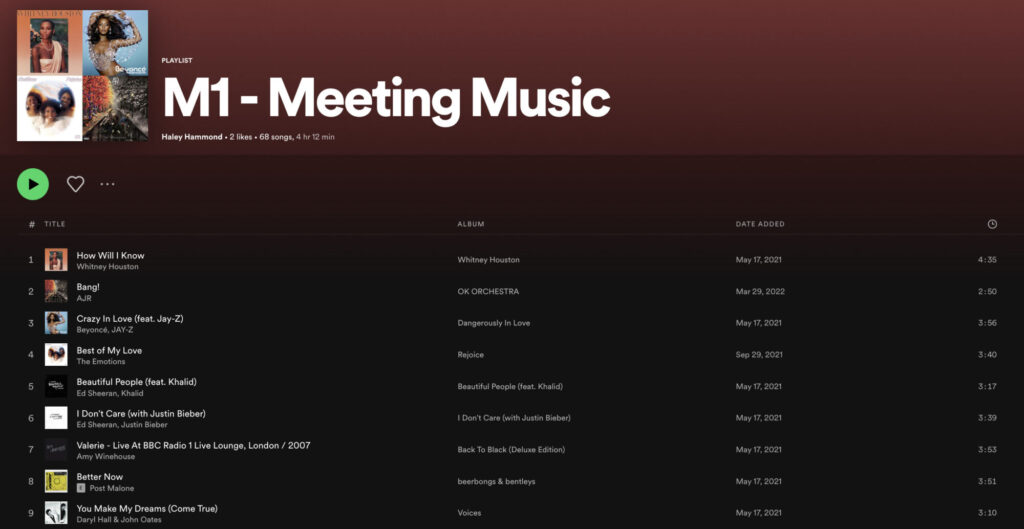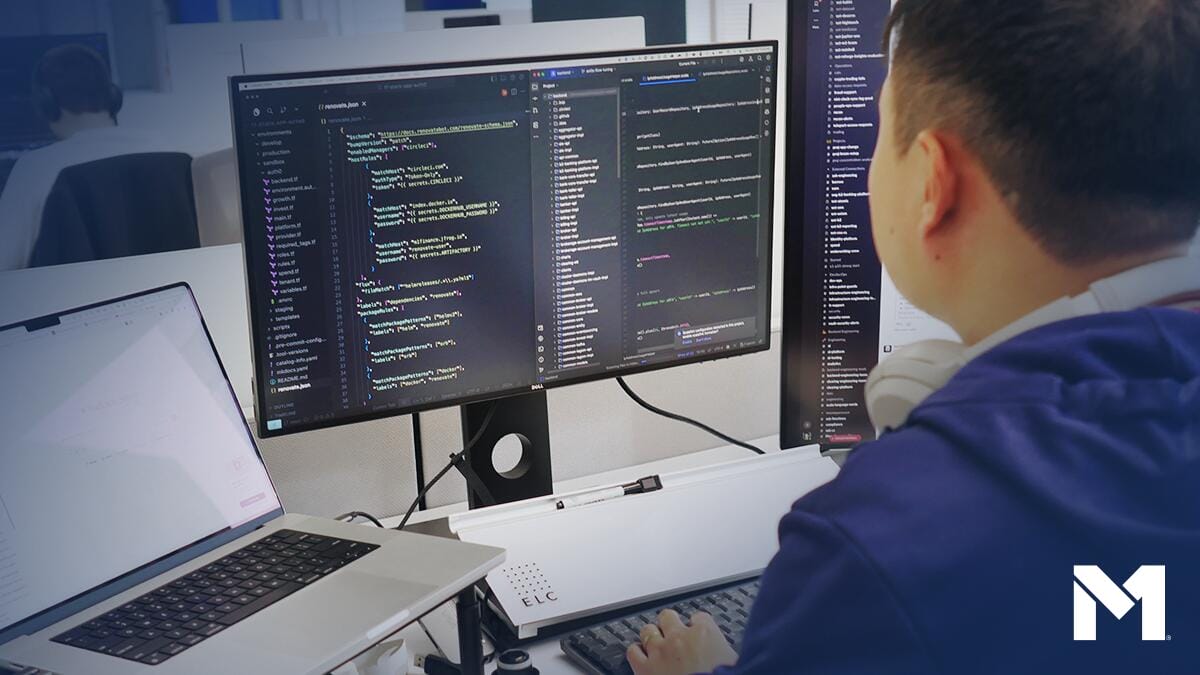Why a hybrid work environment works best for our employees

The only constant is change, especially for post-pandemic hybrid work environments. The way we attend events is different, the way we travel is different, and the way most people work is significantly altered.
M1 is no exception to these changes. Like many companies, we’ve done our best to design a work system that keeps our team moving forward while staying grounded in reality and making human-first decisions.
That’s why we’ve shifted from a company that prioritized in-office time to a hybrid work environment. Why the change? Because M1 is people-first — and whatever works best for our people, works best for us.
To explain this decision, we’ll walk through our new approach with the help of our VP of People, Maria Selvaggio, and our Learning and Development Manager, Haley Hammond.
Adapting to remote work
Our team was in a unique position in 2020. As pandemic-related cuts took place nationwide, we secured our Series B and Series C funding. With money to grow we chose to stay aggressive with our business plans.
“We decided to use the funding to take big swings and put out new products,” Selvaggio says. “To do that, you need people.”
Growing our team from around 100 employees to 350 (all virtually) required changes to our approach. We increased outreach on LinkedIn and doubled our employee referral bonus among other efforts to strengthen our hiring process.
“We didn’t want to hire people just to lose them in a year,” she says. “So, we followed three tenets: People want: 1) a good manager, 2) to see themselves grow, and 3) to have meaningful work. Those are all more important than free lunch,” Selvaggio said.
What change has taught us
To understand the lessons learned, we asked Maria and Haley, “What would you tell your pre-COVID self now about how work has changed?”
Maria Selvaggio said that prior to the pandemic, we used to think that everyone needed to be in the office together to be successful.
“We never imagined hiring outside of Chicago because we felt we needed the in-person face
time to collaborate and problem solve,” said Selvaggio. But during the first few weeks of
lockdown, the team was pleasantly surprised how things were working remotely.
Choosing a hybrid work environment
Moving to a hybrid environment has allowed us to promote a strong sense of individual
autonomy. And while our work adapted more seamlessly than expected, we had to be
intentional so that other critical aspects of our company and culture transitioned well for our
new remote workers. This included employee resources, career development, and company
events.
Employee Resource Groups (ERGs) at M1
After reviewing the results of an employee engagement survey last summer, we saw an
opportunity to improve the sense of belonging. So, alongside our diversity, equity, and inclusion (DEI) task forces, we launched M1 employee resource groups.
Hammond says these groups “create a space for members of different affinities to come
together to have fun, support and develop with one another, and shape M1’s culture.”
Our ERGs currently include:
• Black at M1
• Somos M1 (Latinx ERG)
• Women at M1
• Pride at M1
• Mental Health at M1
These groups plan exciting and educational events, including fireside chats, happy hours, and
mental health training. They also serve as spaces for difficult conversations about work, as well as current events and culture.
Flexible and inclusive L&D programs
Our learning and development (L&D) team collaborates with our ERGs to provide all employees with education on relevant cultural movements.
Whether coordinating a lunch and learn, having a speaker highlight issues, or promoting
heritage months on Slack channels, the L&D team is very active with M1ers to maximize their
growth. The team recently allocated a $1,000 professional development stipend for each
employee to use on any skill they wish to develop.
Company events
When it comes to company events, we’re always sure to provide an option for team members who can’t attend in-person.
“Be cognizant of remote teammates and schedule events for them to enjoy,” said Selvaggio. “Remote events shouldn’t feel like second-rate versions of personal events, and shouldn’t be treated as such.”
Including options like virtual team trivia or a meal stipend for dinner can go a long way, so be sure to include those options in the company budget.
Challenges of a hybrid work environment
Of course, our success moving to a hybrid work environment doesn’t mean we haven’t run into challenges along the way. Here are some roadblocks we’ve experienced and how we’ve pivoted as a team.
Meet everyone where they are
Starting a new job is nerve-wracking, especially for employees onboarding remotely. So, we’ve learned to set expectations before the first day by following a few steps:
- Connect with your IT team to ensure a seamless process for shipping equipment.
- Schedule time for new employees to meet the IT team virtually to ask questions.
- Strive for consistency as you plan a fully remote onboarding and orientation experience using interactive Zoom training.
- Find ways to bring your company’s personality to life to embrace new hires in the culture. For example, we like to play music at the start of virtual company meetings to add energy and cut through awkward silence.

Build ways to connect
Workplace loneliness is at an all-time high. Watercooler moments and serendipitous office interactions helped us get to know peers outside of our teams. Luckily there are plenty of ways to help remote and hybrid teammates create new connections, including:
- ERGs and task forces. These groups give people opportunities to build relationships with like-minded teammates who they may not have otherwise meet.
- Community involvement groups. These groups can coordinate volunteer efforts at local organizations that align with your company’s mission and values.
- “No work allowed” meetings. Encourage employees to meet for monthly virtual coffee breaks or host spontaneous Zoom lunches to discuss books or the latest Netflix binges—no work talk allowed.
Be mindful about meetings
If a meeting can be an email, make it an email. The effects of Zoom fatigue have been well documented. Being intentional about scheduling meetings and assigning tasks can help stave off burnout.
Celebrate your employees
It’s important to recognize your team’s efforts through an employee recognition program. Don’t underestimate the power of employee awards and swag, but make sure to choose recognition techniques that work for your team and company culture.
The future of work at M1
Our team plans to keep a hybrid approach by hiring remote employees and having an office space that’s always open to team members. We believe employees will continue to have a lot of agency around whether they come into the office on a day-to-day basis.
“We hope teams will be able to use the office to meet in person, build trust, brainstorm, and enjoy the company of their coworkers,” said Selvaggio. “They’ll also be able to use their home offices for heads-down work, conversations with remote team members, and whatever feels most productive for them.”
Hammond agrees and envisions M1 with a robust hybrid culture where team members can thrive, regardless of location. “I imagine a place where you can build connections with coworkers and experience everything our culture has to offer, regardless of where you are,” said Hammond. “A hybrid culture allows M1 to have the best people doing their best work in the best place for them!”
Hybrid work is just one reason we’re one of Inc.’s Top American companies to work for.
Explore our open roles or learn more about our team to see what a people-first workplace could do for you.
- Categories
- M1



